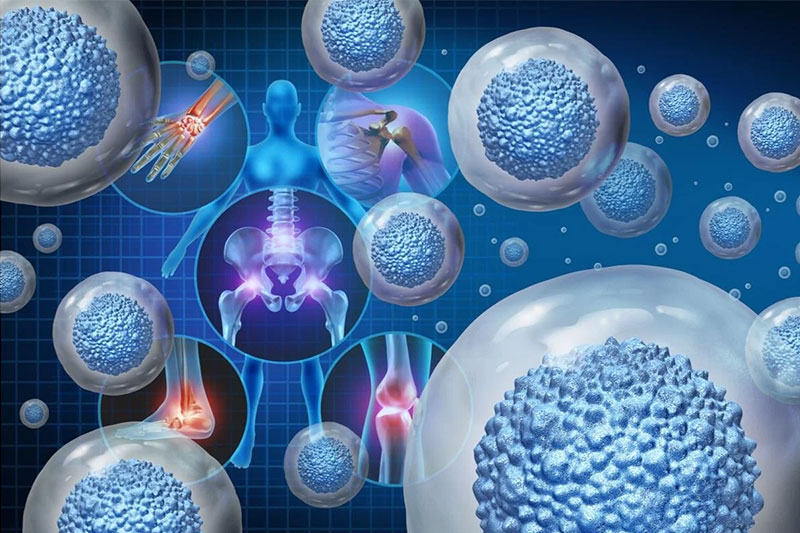
What is Orthobiologics
Orthobiologics is a combination of words: “ortho” refers to the human body (ligaments, tendons, bones, and joints) and “biologics” refers to naturally derived substances used to heal parts of the body. Orthobiologic treatments can be used to harness the body’s ability to heal itself to restore or establish normal function. Within the field of orthopedics, these specific treatments hold great promise for helping patients with injuries or degeneration in the musculoskeletal system.
When joints, ligaments, tendons or discs are damaged, it can lead to chronic pain in the:
- Lower Back
- Knees
- Hips
- Neck
- Feet and ankles
- Hands and wrists
- Elbows and Shoulders
Orthobiologics address the reason for the pain by helping to heal and create new healthy tissues. When the underlying cause of the pain is treated, the pain resolves itself.
How Do Orthobiologics Work?
Orthobiologic treatments for orthopedic conditions use the patient’s own blood and cells called mesenchymal cells (known as autologous products) to kick-start the body’s own healing processes. These biologic products are removed from the patient and concentrated to isolate the healing proteins, molecules and nutrients they contain. These super-healers are then reinjected into the exact site of the damaged tissue to encourage new cell growth and healing.
Limitations on Cellular Therapy by the FDA
The U.S. Food & Drug Administration (FDA) does not allow the use of embryonic or blood cord products for treating orthopedic conditions. But skilled physicians can use these autologous cellular products to treat musculoskeletal problems, provided they follow the FDA’s guidelines for safety and efficacy:
- Platelet Rich Plasma: Platelets in the patient’s own blood release growth factors and proteins that promote tissue repair, while the plasma carries the hormones, electrolytes and nutrients required to nourish cells during the healing process.
- Cellular Treatments: A specific type of cells, called mesenchymal cells, taken from the patient’s own fat tissue (adipose) or bone marrow have the unique ability to develop into the specific kind of cell needed and possess molecules that direct other cells in the injured area to form new blood vessels, awaken other cells and encourage newly forming cells to produce collagen and other proteins essential for creating new healthy tissues.
- Prolotherapy (Proliferative Therapy): Medications that help the body jump-start its own natural healing response are injected into the injured area. Prolotherapy can be used with platelet rich plasma to expedite healing.
Because the platelet-rich plasma and mesenchymal cells are taken directly from the patient and redelivered back to them, they do not present the risk of infections or allergic reactions that donor products do.
The FDA has banned certain language and advertising regarding these types of procedures because of the risk of having an illegal process or not following protocol. For example, using the phrases “stem cell” and “regenerative medicine” have recently been flagged by the FDA as being dangerous and risky phrases. Those phrases are vague and therefore have opened doors to illegal “black market” type of cell buying and procedures that are potentially dangerous to patients. When specific, federally-approved procedures (like those listed above) are offered by certified physicians, that means they are in good standing with the law – and the procedures are going to be effective.
Is Regenerative Medicine Painful?
For many years, patients with unresolved chronic orthopedic pain were left to consider surgery as their last, best hope for long-term pain relief. But with advancements in regenerative medicine, these patients can avoid major surgery and lengthy rehab.
Orthobiologic treatments are conducted with needles. Blood plasma and mesenchymal cells are aspirated (removed via a needle) and reinjected through a needle. There are no large incisions, which means the risk of bleeding and infection is significantly reduced. It also means that the procedures can be performed on an out-patient basis and recovery begins at home within hours of the treatment.
Best of all, patients can enjoy long-lasting pain relief and enjoy quality of life without chronic pain.
Ask the Right Questions, Get the Best Results
When considering regenerative medicine to treat orthopedic conditions, patients should make sure:
- The physician performing the procedure is board-certified in pain medicine.
- Advanced centrifuge technology is used to prepare the cellular products so that they offer the highest possible concentrations of healing properties.
- Treatments are given under fluoroscopic (X-ray) or ultrasound guidance to ensure precise delivery of the regenerative products to the exact site of the injury.
- The practice acknowledges and strictly follows FDA guidelines for the use of cellular products to treat musculoskeletal damage.
The best outcomes occur when the patient understands the benefits of regenerative treatments and knows the right questions to ask before the procedure.
Nashville Regenerative is a state-of-the-art practice focusing on Orthobiologics to treat orthopedic conditions. To learn more about the procedures they provide, visit their website or fill out the form below. We look forward to helping you regain your quality of life.

